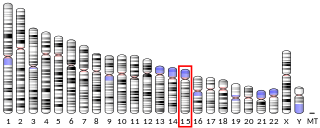Vesicular glutamate transporter 3 (VGLUT3) is a protein that in humans is encoded by the SLC17A8 gene. [5]
Vesicular glutamate transporter 3 (VGLUT3) is a protein that in humans is encoded by the SLC17A8 gene. [5]
This gene encodes a vesicular glutamate transporter. The encoded protein transports the neurotransmitter glutamate into synaptic vesicles before it is released into the synaptic cleft. [5]
Mutations in this gene are the cause of autosomal-dominant nonsyndromic deafness type 25 (DFNA25). [6] [7]
Glutamate transporters are a family of neurotransmitter transporter proteins that move glutamate – the principal excitatory neurotransmitter – across a membrane. The family of glutamate transporters is composed of two primary subclasses: the excitatory amino acid transporter (EAAT) family and vesicular glutamate transporter (VGLUT) family. In the brain, EAATs remove glutamate from the synaptic cleft and extrasynaptic sites via glutamate reuptake into glial cells and neurons, while VGLUTs move glutamate from the cell cytoplasm into synaptic vesicles. Glutamate transporters also transport aspartate and are present in virtually all peripheral tissues, including the heart, liver, testes, and bone. They exhibit stereoselectivity for L-glutamate but transport both L-aspartate and D-aspartate.

The solute carrier family 18 member 2 (SLC18A2) also known as vesicular monoamine transporter 2 (VMAT2) is a protein that in humans is encoded by the SLC18A2 gene. SLC18A2 is an integral membrane protein that transports monoamines—particularly neurotransmitters such as dopamine, norepinephrine, serotonin, and histamine—from cellular cytosol into synaptic vesicles. In nigrostriatal pathway and mesolimbic pathway dopamine-releasing neurons, SLC18A2 function is also necessary for the vesicular release of the neurotransmitter GABA.

Excitatory amino-acid transporter 5 (EAAT5) is a protein that in humans is encoded by the SLC1A7 gene.

Excitatory amino-acid transporter 4 (EAAT4) is a protein that in humans is encoded by the SLC1A6 gene.

Wolframin is a protein that in humans is encoded by the WFS1 gene.

Gap junction beta-3 protein (GJB3), also known as connexin 31 (Cx31) — is a protein that in humans is encoded by the GJB3 gene.

Sodium- and chloride-dependent creatine transporter 1 is a protein that in humans is encoded by the SLC6A8 gene.

Potassium voltage-gated channel subfamily KQT member 4, also known as voltage-gated potassium channel subunit Kv7.4, is a protein that in humans is encoded by the KCNQ4 gene.

Non-syndromic hearing impairment protein 5 is a protein that in humans is encoded by the DFNA5 gene.

TRIO and F-actin-binding protein is a protein that in humans is encoded by the TRIOBP gene.

Alpha-tectorin is a protein that in humans is encoded by the TECTA gene.

Y+L amino acid transporter 1 is a protein that in humans is encoded by the SLC7A7 gene.

Sodium- and chloride-dependent glycine transporter 2, also known as glycine transporter 2 (GlyT2), is a protein that in humans is encoded by the SLC6A5 gene.

Eyes absent homolog 4 is a protein that in humans is encoded by the EYA4 gene.

Zinc transporter 4 is a protein that in humans is encoded by the SLC30A4 gene.

Cytoplasmic dynein 2 heavy chain 1 is a protein that in humans is encoded by the DYNC2H1 gene.

Vesicular inhibitory amino acid transporter is a protein that in humans is encoded by the SLC32A1 gene.

Vesicular glutamate transporter 1 (VGLUT1) is a protein that in humans is encoded by the SLC17A7 gene.

Transmembrane channel-like protein 1 is a protein that in humans is encoded by the TMC1 gene. TMC1 contains six transmembrane domains with both the C and N termini on the endoplasmic side of the membrane, as well as a large loop between domains 4 and 5. This topology is similar to that of transient receptor potential channels (TRPs), a family of proteins involved in the perception of senses such as temperature, taste, pressure, and vision. TMC1 has been located in the post-natal mouse cochlea, and knockouts for TMC1 and TMC2 result in both auditory and vestibular deficits indicating TMC1 is a molecular part of auditory transduction.

Myosin-XV is a protein that in humans is encoded by the MYO15A gene.
This article incorporates text from the United States National Library of Medicine, which is in the public domain.